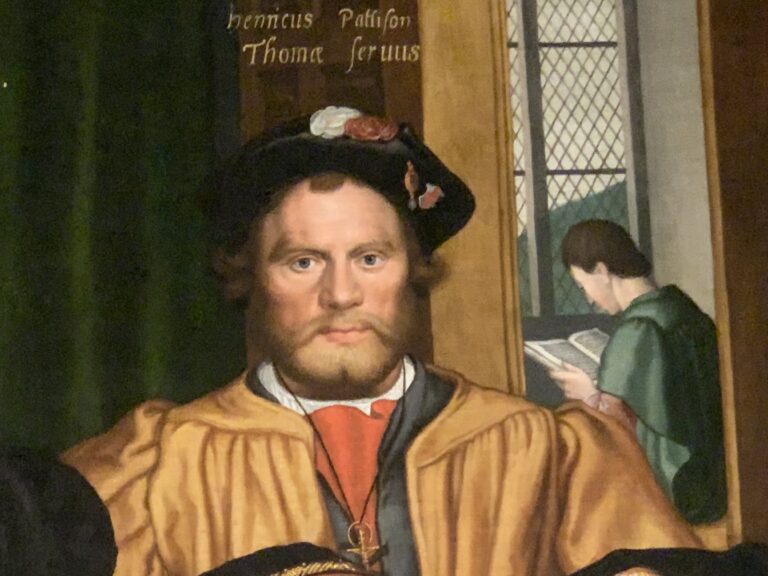Any given Friday may well find me staring at the largest painting I have ever seen, whilst trying to look both welcoming and approachable.
I’m a National Trust room guide, and every now and then I find myself sitting in the North Hall at Nostell near Wakefield. The painting in question is ‘‘Sir Thomas More and his Family’’, the only remaining full-sized copy of a lost original by Hans Holbein. Painted in 1592 by Rowland Lockey, the family portrait contains all the usual allusions to traits prized by the More family.
So why, I wonder, does More choose to put Henry Patenson in such a full-faced, prominent position? Patenson stares directly at me as I wonder what on earth a family jester would need to bring to the party in order to justify his board and lodging.
*
“There are a number of distinctions that need to be made within the two clear categories [of fool] that can be established, the “natural” and the “artificial”. The natural fool can be classed as a simpleton, slow, feebleminded, even an idiot in the technical sense of being severely subnormal. The artificial fool was one of the following, or a combination of, buffoon or clown, whose talent lay in uninhibited slapstick, a comic who indulged in extempore slick verbal wit, or a jester who offered more contrived light-hearted entertainment. Both kinds were employed as court and domestic fools, the first category as much laughed at for their mental, and even physical, deficiencies as for their antics. Wolsey’s Patch fits into the natural group, while Henry VIII’s Will Somers, depicted as having characteristics of shrewdness and intuition, belongs to the artificial. On the evidence available, Henry Patenson too can be put in the latter class.”1
*
From AD400 onwards the Christmas tradition of appointing a Lord of Misrule took root within Catholic tradition. Philip Stubbes wrote in his Anatomie of Abuses (1585), that “the wilde heades of the parishe conventynge together, chuse them a grand Capitaine (of mischeefe) whom they ennobel with the title Lorde of Misrule.” He then describes how they dress colourfully, tie bells onto their legs, and “go to the churche (though the minister be at praier or preachyng) dauncying and swingyng their handercheefes.”2
Henry VIII removed Thomas More’s head in 1535 and abolished the custom in 1541, only for it to be reestablished by Catholic Mary I. The rise to the throne of Protestant Elizabeth I and the era of Puritanism that became a force during her reign saw the end of a custom that has never returned.
*
Before the crowds arrive, Nostell is quiet and I sit staring at the great painting. It is though Henry Patenson is reminding me of Dostoevsky’s The Idiot. I was forced to read it twice because I’d not realised that the use of patronymic names in Russian novels can make the cast of characters look a lot larger than the author intended. The central character, Prince Myshkin, is considered an idiot by everyone around him but Dostoevsky is playing with literary convention by exploring ‘the consequences of placing such a singular individual at the centre of the conflicts, desires, passions, and egoism of worldly society, both for the man himself and for those with whom he becomes involved’.3
I wonder what it must be like inviting someone into your household simply to act as a fool. We don’t know whether Henry performed on special occasions, or whether he was a permanent presence with free rein. Neither do we know whether he made a fool of himself or poked fun at the family. But Thomas clearly valued his jester highly, and I begin to wonder what life would be like if I could take life less seriously.
*
As a child I hated being the butt of a joke. I’m sure no one really enjoys it but I would react to the slightest ribbing as if my world had caved in. For a disabled child whose sense of self was so strongly defined by doing everything at least as well as everyone else, maybe it had.
It is not difficult to find comedy today. We have radio, TV on demand and a nationally known comedian is probably performing tonight in a theatre or comedy club near you. There is something of the fool in many of our best loved comedians, and it is often their most vulnerable routines that we resonate with. But it is they who are being vulnerable, and we know how some of the best loved comedians of our age have struggled with depression, addictions and fragile mental health.
*
When Paul wrote his ironic words to the Church in Corinth that he and his companions were acting as fools for Christ’s sake, whilst they appeared so wise according to the dominant philosophy of their city, he was urging them to take notice of the apparent foolishness at the heart of the Christian message.4 Jesus refused to play the power games that polarise and divide. We are invited to take up our own cross which marks both a death and an entry point for grace.
As we draw toward the end of a year during which those who were not listening to each other in January seem less likely to do so in December I fear where our all too serious obsession with defensiveness and suspicion might be taking us.
We need a cast of holy fools. Roll up, roll up….
1 Noeline Hall. Moreana; Angers Vol. 27, Iss. 101/102, (May 1990)
2 https://en.wikipedia.org/wiki/Lord_of_Misrule
3 https://en.wikipedia.org/wiki/The_Idiot
4 1 Corinthians 4:10


